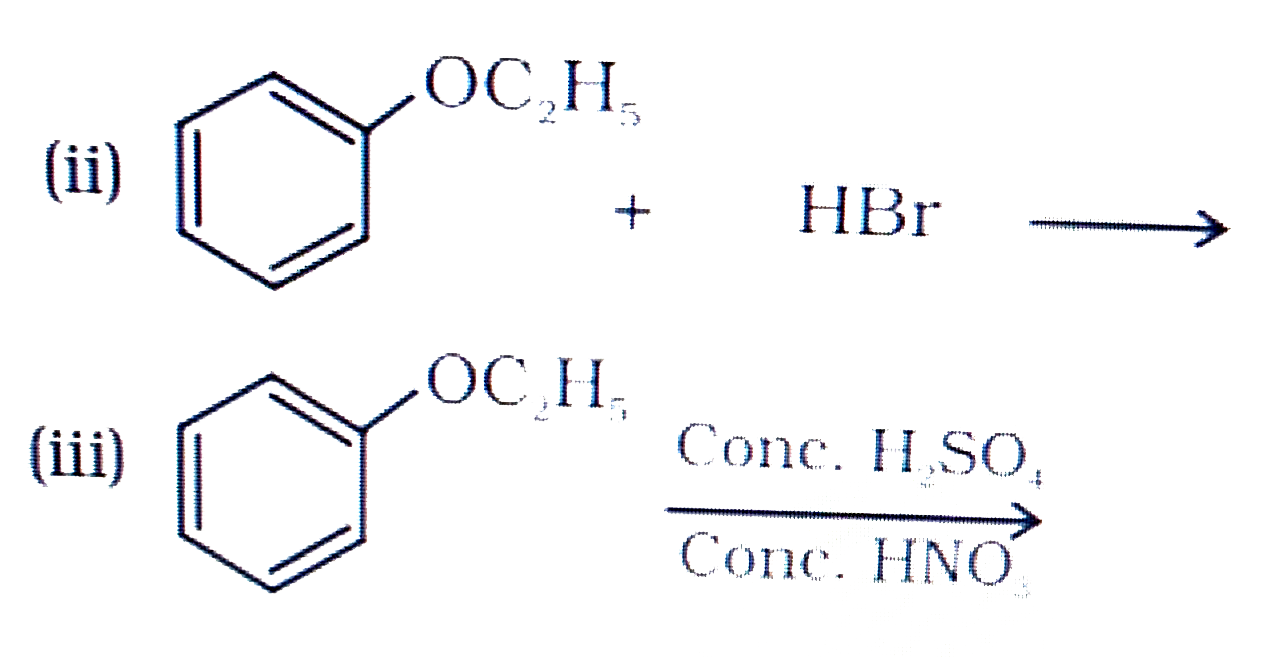Identify and explain the formation of the products in the following reaction :
CH3 |CH3−C−CH2Br C2H5OH−−−−−−−→heat | CH3
To solve the problem, we need to analyze the reaction of 2-bromo-2,2-dimethylpropane with ethanol (C2H5OH) under heat. Let's break down the steps:
Step 1: Identify the Reactant
The reactant is 2-bromo-2,2-dimethylpropane, which has the following structure:
- The carbon backbone consists of a central carbon (C) bonded to:
- Two methyl groups (CH3)
- One bromine atom (Br)
- One ethyl group (C2H5) when the reaction occurs with ethanol.
Step 2: Reaction with Ethanol
When 2-bromo-2,2-dimethylpropane is heated with ethanol, the bromine atom is replaced by an ethoxy group (OC2H5). This is a nucleophilic substitution reaction where the bromine (a good leaving group) is replaced by the ethoxy group from ethanol.
Step 3: Formation of Carbocation
Upon heating, the bromine atom leaves, forming a carbocation. In this case, the carbocation formed is a primary carbocation (due to the structure of the reactant). However, primary carbocations are unstable and can undergo rearrangement.
Step 4: Methyl Shift
To stabilize the carbocation, a methyl shift occurs. A methyl group from one of the adjacent carbon atoms migrates to the positively charged carbon atom, converting the primary carbocation into a more stable tertiary carbocation.
Step 5: Nucleophilic Attack
The ethoxide ion (C2H5O-) from ethanol then attacks the newly formed tertiary carbocation. This results in the formation of the final product.
Step 6: Final Product
The final product of the reaction is 2-ethoxy-2-methylbutane. The structure can be represented as:
- A central carbon (C) bonded to:
- Two methyl groups (CH3)
- One ethoxy group (OC2H5)
- One additional carbon (CH2) from the ethyl group.
Summary of the Reaction
The overall reaction can be summarized as:
2-bromo-2,2-dimethylpropane+C2H5OHheat−−→2-ethoxy-2-methylbutane+HBr
The reactant is 2-bromo-2,2-dimethylpropane, which has the following structure:
- The carbon backbone consists of a central carbon (C) bonded to:
- Two methyl groups (CH3)
- One bromine atom (Br)
- One ethyl group (C2H5) when the reaction occurs with ethanol.
When 2-bromo-2,2-dimethylpropane is heated with ethanol, the bromine atom is replaced by an ethoxy group (OC2H5). This is a nucleophilic substitution reaction where the bromine (a good leaving group) is replaced by the ethoxy group from ethanol.
Upon heating, the bromine atom leaves, forming a carbocation. In this case, the carbocation formed is a primary carbocation (due to the structure of the reactant). However, primary carbocations are unstable and can undergo rearrangement.
To stabilize the carbocation, a methyl shift occurs. A methyl group from one of the adjacent carbon atoms migrates to the positively charged carbon atom, converting the primary carbocation into a more stable tertiary carbocation.
The ethoxide ion (C2H5O-) from ethanol then attacks the newly formed tertiary carbocation. This results in the formation of the final product.
The final product of the reaction is 2-ethoxy-2-methylbutane. The structure can be represented as:
- A central carbon (C) bonded to:
- Two methyl groups (CH3)
- One ethoxy group (OC2H5)
- One additional carbon (CH2) from the ethyl group.
The overall reaction can be summarized as:
2-bromo-2,2-dimethylpropane+C2H5OHheat−−→2-ethoxy-2-methylbutane+HBr
Similar Questions
Knowledge Check
The major product formed in the following reaction is
CH3−CH3∣C∣H−CH2BrCH3O−−−−−→CH3OHACH3−CH3∣C∣H−CH2OCH3BCH3−CH∣OCH3−CH2CH3CCH3−CH3∣C=CH2DCH3−CH3∣C∣OCH3−CH3
What would be the major products in the following reactions:
CH3−CH3∣C∣CH3−CH2BrC2H5OH−−−−→Δ
View SolutionThe major product formed in the following reation is
CH3−CH3∣C∣H−CH2−BrCH3ONa−−−−−→CH3OH .
View SolutionThe major product of the following reaction is :
CH3C∣BrHCH2C∣BrHCH2CH3KOH,CH3OH−−−−−−−−−−−→heat
View SolutionWhat is the product of the following reaction : CH3−C∣CH3=CH2HBr−−−−→Peroxide
View SolutionIdentify the major product in the following reactions :
C6H5−CH2−H∣C∣Br−CH3Alc.KOH−−−−−→Δ?HBr−−→ ?
View SolutionThe major product of the following reaction is:
CH3−CH3∣C∣H−CHCH3∣BrCH3OH−−−−→
View SolutionPredict the products of the following reactions:
(i) CH3−CH2−CH2−O−CH3+HBr→

(iv) (CH3)3C−OC2H5HI−−→
View Solution
